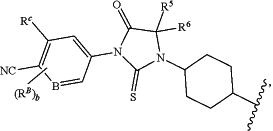| CPC C07D 401/14 (2013.01) [A61P 35/00 (2018.01)] | 15 Claims |
|
1. A compound of formula I
 or a pharmaceutically acceptable salt, tautomer, isotopolog, or stereoisomer thereof, wherein
RN is H;
n is 0-4;
each R1 is independently selected from halogen, CN, and C1-3 alkyl;
a is 1 or 2;
R2 and R3 are each independently selected from H, and C1-3 alkyl, or R2 and R3 and the carbon to which they are attached form a substituted or unsubstituted C3-6 cycloalkyl;
m is 0-8;
each R4 is independently substituted or unsubstituted C1-3 alkyl, or two R4 groups, together with the same carbon atom or adjacent carbon atoms to which they are attached, form a substituted or unsubstituted C3-6 cycloalkyl, or two R4 groups together with the non-adjacent carbon atoms to which they are attached form a substituted or unsubstituted 4-7-membered heterocyclyl;
X is N or CRX;
RX is hydrogen, halogen, —O(C1-6 alkyl) or —(C1-9 alkyl);
L is substituted or unsubstituted —O(C1-6 alkyl)-, —(C1-6 alkyl)O—, —O(C1-6 alkyl)O—, or —(C1-9 alkyl) -;
V is
 wherein
B is N, CH, or CRB,
each RB is independently selected from halogen, and substituted or unsubstituted C1-6 alkyl;
RC is halogen, CF3 or SF5;
R5 and R6 are C1-3 alkyl, or R5 and R6, together with the carbon atom to which they are attached, form a substituted or unsubstituted C3-6 cycloalkyl or a 3-6 membered heterocyclyl; and
b is 0-2.
|